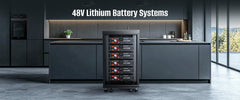
48V Lithium Battery Systems: The Smart Power Choice for RVs, Boats, and Off-Grid Homes
, 7 min reading time


, 7 min reading time
Have you ever had to turn off your RV’s air conditioner because your batteries couldn’t handle the load? Or noticed your boat’s fridge and electronics draining the system far too quickly? These are common struggles with traditional 12V and 24V systems—they simply weren’t designed for today’s high-demand lifestyle.
The reality: modern appliances need more power, and older systems hit limits in efficiency, wiring, and reliability. That’s where 48V lithium battery systems step in. They’re not just an upgrade—they’re a smarter, more future-proof foundation for powering your adventures, whether on the road, at sea, or completely off the grid.
The difference comes down to a simple formula:
Power (W) = Voltage (V) × Current (A)
If your appliance requires 1200W:
That’s a 75% reduction in current, which brings three huge advantages:
1.1. Lower Energy Loss
Line loss is proportional to the square of current (P_loss = I²R). Cutting the current by 75% reduces waste by a factor of sixteen. That means more stored energy reaches your devices.
1.2. Smaller, Lighter Wiring
Less current = thinner cables = less weight, easier installation, and lower costs.
1.3. Higher Efficiency for Equipment
Inverters, chargers, and MPPT controllers run cooler and last longer when operating at higher voltage.
Quick System Voltage Comparison
|
System Voltage |
Ideal For |
Advantages |
Limitations |
|
12V |
Small RVs, basic setups |
✔ Widely available, simple setup |
✘ High current = heavy cables, losses |
|
24V |
Mid-sized systems |
✔ Balance of simplicity & efficiency |
✘ Still limited for big loads |
|
48V |
Large RVs, boats, off-grid homes |
✔ Maximum efficiency, supports large appliances |
✘ Requires compatible equipment |
So what does this mean for your adventures?
• Run More Appliances with Ease
Air conditioners (~1,500–2,000W), induction cooktops, water makers, and entertainment systems—48V lets you run them all at once without overloading cables.
• Boost System Efficiency
Perfect for boats, large RVs, or off-grid homes with long cable runs, where every watt of saved energy matters.
• Save Space and Weight
Combine thinner wiring with LiFePO₄ batteries’ higher energy density for a lighter, more compact system.
• Seamless Solar Integration
Most modern solar arrays are designed to pair with 48V, reducing conversion losses and increasing your solar ROI.
• Longer Lifespan & Safer Chemistry
LiFePO₄ = thousands of charge cycles, stable voltage curve, and excellent thermal safety.
☛ Example in Action: The Sunrich Energy 51.2V 100Ah LiFePO₄ Battery features a built-in BMS for protection against overcharge, over-discharge, and short circuits. Its stable 48V platform and exceptional cycle life make it an ideal foundation for any high-demand system.
Like any advanced system, 48V setups come with considerations. Here’s what to expect—and how to handle it:
• Compatibility with 12V Devices
Most RV and marine accessories (lights, fans, USB outlets) run on 12V.
✔ Fix: Add a high-efficiency DC-DC converter to step down from 48V to 12V or 24V.
• Higher Initial Cost
48V inverters, MPPT controllers, and batteries cost more upfront.
✔ Fix: Long-term savings on wiring, improved efficiency, and longer component life quickly offset the investment.
• Installation & Safety
Higher voltages require careful wiring, fusing, and proper code compliance.
✔ Fix: Use professional installation, including main disconnects and breakers, and size cables correctly.
• Large RVs and Motorhomes
Power air conditioning, cooking appliances, and entertainment systems—all without running a noisy generator.
• Marine Applications (Boats & Yachts)
Bow thrusters, navigation electronics, desalination, and comfort systems demand stable power. 48V reduces cable weight, increases efficiency, and improves safety at sea.
• Off-Grid Homes and Cabins
For 24/7 household energy, 48V integrates seamlessly with large solar arrays and high-capacity inverters—delivering reliable, future-proof energy independence.
Core Components:
Safety & Expandability:
* Simple System Flow
[ Solar Panels ] → [ MPPT Controller ] → [ 48V LiFePO₄ Battery Bank ] → [ Inverter/Charger ] → [ AC Loads ]
│
└─> [ DC-DC Converter ] → [ 12V DC Loads ]
Q1: Can I upgrade my existing 12V RV system to 48V?
Yes, but it usually requires a new inverter/charger and solar controller. Most users keep their 12V accessories by adding a DC-DC converter.
Q2: Do I need to replace all my devices?
No. Your 12V lights, fans, and outlets can stay—just step down from 48V with a converter.
Q3: Is 48V safe to handle?
Yes, when installed properly with disconnects, breakers, and fuses. It’s safer than AC mains power but requires professional installation for best results.
Q4: Does a 48V system charge faster?
Often, yes. Higher voltage reduces losses and allows MPPT controllers and chargers to operate more efficiently, cutting charging time compared to 12V or 24V setups.
While a 48V system costs more upfront, the savings add up:
For frequent RV travelers, boat owners, or off-grid homeowners, the efficiency gains pay for themselves—while delivering comfort and reliability wherever you go.
12V and 24V systems can’t keep up with today’s energy demands. A 48V lithium battery system delivers:
Whether you’re building the ultimate RV, equipping a yacht, or powering an off-grid home, 48V systems provide a true path to energy independence.
⚡Ready to design a reliable 48V system??
Discover the Sunrich Energy 51.2V LiFePO₄ Battery Series—a safe, efficient, and dependable foundation for your next adventure.
Have questions? Contact our energy experts for tailored guidance.